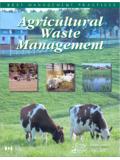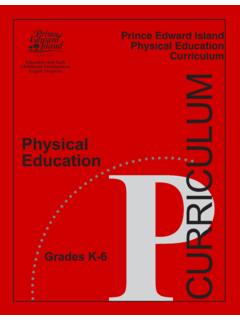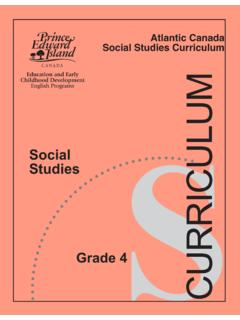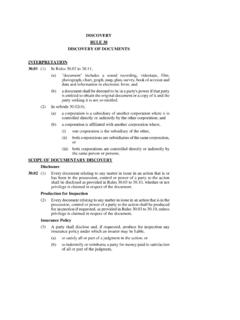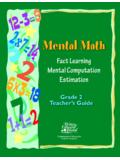Transcription of 4-H Rabbit Manual
1 4-H Rabbit Manual Publication #1250. Version 12/08. 4-H Rabbit LEADERS GUIDE Publication #1240. The 4-H Pledge I pledge: Senior Projects include: Possible My Head to clearer thinking My a) Crossbreeding Heart program to greater loyalty My b). Hands to largerof Comparison service crossbred and purebred rabbits My Health to better living For c). myDesigning club, my and buildingand community a rabbitry my country.. d) Participating in an open show circuit with purebred rabbits The 4-H Motto Learn to do by e) Effects ofdoing genetics on coat color f) Rabbit skin tanning Provincial 4-H Office 5653g) Hwy 6 N, RR. Compare the5cost of rate of gain between high and low energy rations. Guelph, ON N1H 6J2. h) A study of breeds and their characteristics. 1-877-410-6748. PH:i)519-824-0101. Carcass composition and retail value. FX: 519-824-8759. j) Parasites, Email: diseases, and other health problems.
2 K) Any other topic of interest related to rabbits Website This project was produced and written by BC 4-H, and was released through the Canadian 4-H Council Resource Network. Thank you to Karen Killman for reading through, and editing the project for use by 4-H Ontario. Release Date: December, 2009. 6. 4-H Ontario grants permission to 4-H volunteers to photocopy this 4-H program resource for use in their local 4-H program. INTRODUCTION. 4-H Rabbit Manual Publication #1250. TABLE OF CONTENTS. Introduction .. 2. Record Keeping .. 2. Animal Care .. 2. Project Selection .. 3. 3. Breeds .. 3. Tips for Purchasing a 4-H Project Animal .. 9. Feeding and Nutrition .. 10. Digestion .. 10. Food 11. Classes of Feed .. 12. Feeding Program 14. Facilities .. 15. Housing .. 15. Materials .. 17. Other 18. 20. Ventilation and Temperature .. 21. Husbandry and Health .. 22. Husbandry.
3 22. Identification .. 22. Nail 23. Disease Prevention .. 23. Common Rabbit Health Problems .. 24. Administration of Medications .. 28. Breeding .. 29. Selecting Rabbits to Breed .. 29. Principles of Breeding .. 30. Pregnancy .. 31. 32. Weaning .. 33. Record Keeping .. 34. Showing Rabbits .. 37. Handling .. 37. Training .. 39. Grooming .. 40. Showmanship .. 40. Marketing .. 46. Marketing Rabbit Products .. 46. Advertising .. 47. Glossary .. 48. 55. 1. 4-H Rabbit Manual Publication #1250. Introduction Welcome to the 4-H Rabbit project. This project is organized to provide experience for young people in the selection, feeding, husbandry, and exhibiting of rabbits. Handling live animals, watching them grow, and learning how to care for them has value far beyond that of competition. This fact should be kept in mind by the 4-H Club member at all times. Record Keeping Record keeping is a very important part of 4-H project work.
4 Records should be kept accurately, neatly, and continuously. The completed 4-H record book should tell the complete story of the 4-H project from the time it was born or purchased until the end of the project. A completed record book is necessary for 4-H Achievement. Animal Care 4-H members are responsible for providing the highest quality of care for their 4-H project(s). This can be achieved by ensuring that the Five Freedoms of animal care are being provided. Five Freedoms 1. Freedom from Hunger and Thirst provide access to fresh water and adequate feed. 2. Freedom from Discomfort provide appropriate shelter from the elements and a comfortable resting area. 3. Freedom from Pain, Injury or Disease take steps to prevent accidents and disease, monitor health, and provide rapid treatment when disease or injury is detected. 4. Freedom to Express Normal Behaviour - provide sufficient space and company of the animal's own kind.
5 5. Freedom from Fear and Distress - ensure conditions and treatment which do not alarm the animal. 2. INTRODUCTION. 4-H Rabbit Manual Publication #1250. Project Selection History Rabbits are small mammals closely related to hares and picas. This group of animals is known as the Lago- morphs. There are many species in the Rabbit family but all domesticated rabbits are believed to have de- scended from a single species known as the European Rabbit . Breeding of rabbits in captivity first began in the Middle Ages, when they were first considered farm animals. By the 1500's selective breeding resulted in several distinct breeds. The exhibition of rabbits and the keeping of rabbits as pets was popularized in the 1800's. People worldwide raise rabbits for a variety of purposes including: food, wool, fur and pet stock. Breeds In North America there are approximately 50 recognized breeds of domestic Rabbit .
6 The American Rab- bit Breeders Association (ARBA) sets official breed standards for recognized Rabbit breeds. These breed standards are published in a guide called the Standard of Perfection. For detailed information on Rabbit breed standards, 4-H members should consult the ARBA website and publications. Common Rabbit Breeds There are too many Rabbit breeds to fully describe in this Manual . Below are descriptions of a few com- mon breeds. The breeds described below are divided into three categories: commercial, fancy and wool. Many breeds of Rabbit are multi-purpose and could fit into more than one of those categories (for example the Jersey Wooly could be considered both a wool Rabbit and a fancy Rabbit ). When selecting a 4-H project animal consider which unit you plan to enroll in and what animals in that unit will be evaluated on. Unit I Commercial Type Breeding Stock Rabbits should have excellent meat producing qualities, emphasis should be placed on body and muscling Unit II Fancy Type Breeding Stock Rabbits should be good representatives of their breed (or breeds if a crossbred), emphasis should be placed on breed features Unit III Wool Type Breeding Stock Rabbits should have a wool coat, emphasis should be placed on coat quality Unit IV Doe with Litter Breed is irrelevant Unit V Market Rabbit Rabbits should have excellent meat producing qualities Unit VI Pen of Three Rabbits should have excellent meat producing qualities Unit VII Replacement Breeding Project Breed is irrelevant Unit VIII - Marketable Rabbit Raising Breed is irrelevant Unit X Advanced Skill Breed is irrelevant Rabbits in all units will also be evaluated on their general type, health and condition.
7 3 PROJECT SELECTION. 4-H Rabbit Manual Publication #1250. Commercial Breeds CALIFORNIAN Adult Size: Bucks 8 - 10 lbs ( - kg), Does lbs ( - kg). DESCRIPTION: The Californian was first bred in the 1920's, with the intent of creating a better commercial meat Rabbit . It resulted from crosses between the Himalayan, the Standard Chinchilla, and the White New Zealand. The Californian is white with pink eyes and dark points on the ears, feet and tail. The colour of the points can be black, chocolate, blue or lilac. NEW ZEALAND Adult Size: Bucks 9 - 11 lbs ( - kg), Does 10 - 12 lbs ( - kg). DESCRIPTION: The New Zealand is a very popu- lar commercial Rabbit available in three colors: white, red and black. New Zealands should have deep, wide bodies and smooth flesh covering. This multi-purpose breed can be raised for meat, pelts, show, and laboratory purposes. FLORIDA WHITE Adult Size: Bucks and Does, 4 - 6 lbs ( kg).
8 DESCRIPTION: The Florida White is believed to have resulted from crosses between Dutch, Polish, and New Zealand White rabbits. Although it is smaller than many of the other commercial breeds, the Florida White is ideal for the small fryer market. Florida Whites are to be pure white with pink eyes. SATIN Adult Size: Bucks lbs ( - kg), Does 9 to 11 lbs ( - kg). DESCRIPTION: The Satin resulted from a genetic mutation found first in a litter of Havanas. Satin fur appears more brilliant in color compared to normal furred rabbits because the hair shaft has a smaller diameter and the hair is also more transparent. They are a commercial type Rabbit , with one of the best meat to bone ratios. 4 PROJECT SELECTION. 4-H Rabbit Manual Publication #1250. Fancy Breeds DUTCH Adult Size: Bucks and Does, - lbs ( - kg). DESCRIPTION: The Dutch is a very popular breed easily distinguished by its markings.
9 The markings consist of a white blaze, a white stripe around the front torso (including front legs), white on the ends of the hind feet. The rest of the body is to be black, blue, chocolate, brown- gray, steel, or tortoise. Because the markings are a pure genetic trait, Dutch patterns can also appear in other breeds of Rabbit . ENGLISH SPOT Adult Size: Bucks and Does, 5 - 8 lbs ( - kg). DESCRIPTION: This breed is mostly white, with coloring on the nose, ears, around the eyes, and chains of colored spots along its sides includ- ing a stripe down its spine. When breeding English Spots, only about 50% of the young will exhibit the characteristic breed markings; the other 50% will be a combination of solid colored rabbits called selfs . and lightly marked rabbits called charlies . The English Spot has a full arch body type so it should carry its body well up off the ground.
10 BELGIAN HARE Adult Size: Bucks and Does, 6 - lbs ( - kg). DESCRIPTION: Though it is a breed of domestic Rabbit and not a true hare, the Belgian's lean, arched body, large ears, and en- ergetic temperament led to its misleading breed name. The fur color is to be rich red, of a tan or chestnut shade. Rich black lacing on the ears is also desirable. REX DESCRIPTION: The Rex and the Mini Rex are differentiated from normal furred breeds by their unique fur coat. Rex fur is very dense, its guard hairs are nearly the same length as the undercoat giving a plush, velvet like feeling. Rex fur is very short and should have a springy resistance to the touch. Rex Adult Size: Bucks - lbs ( - kg), Does 8 - lbs ( - kg). Mini Rex Adult Size: Bucks 3 - lbs ( - kg), Does - lbs ( - kg). NETHERLAND DWARF Adult Size: Bucks and Does, not over lbs ( kg). DESCRIPTION: The Netherland Dwarf is one of the smallest breeds.
